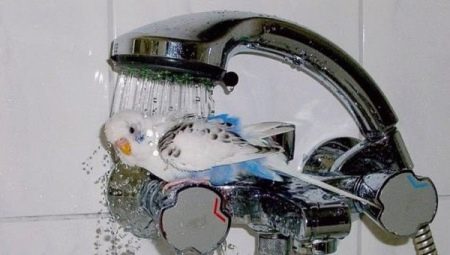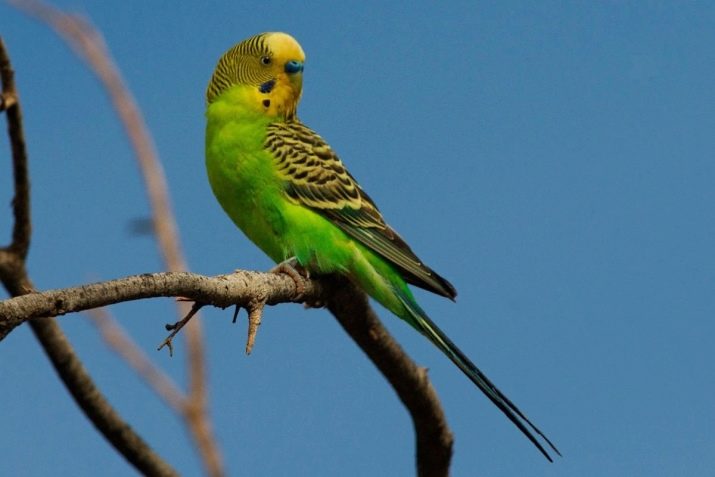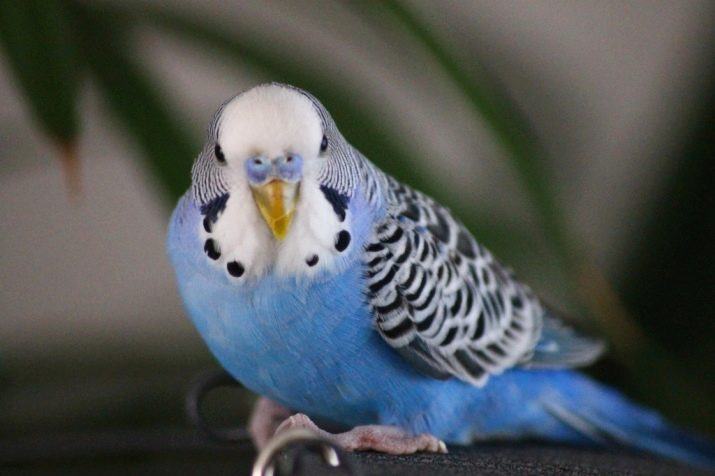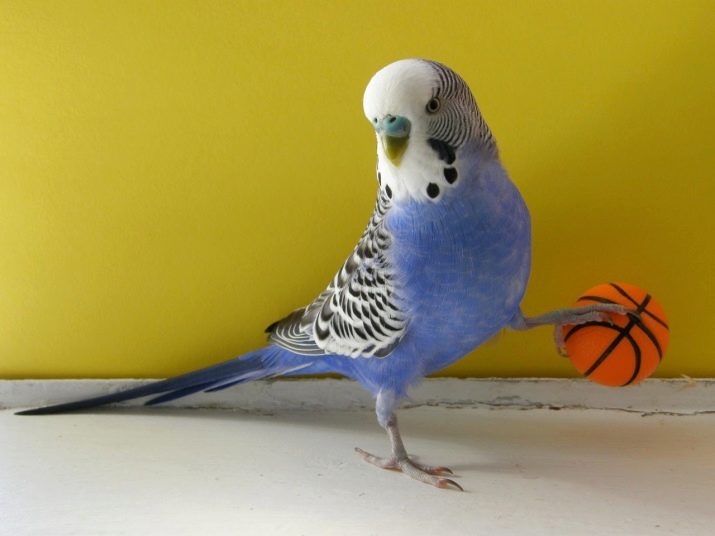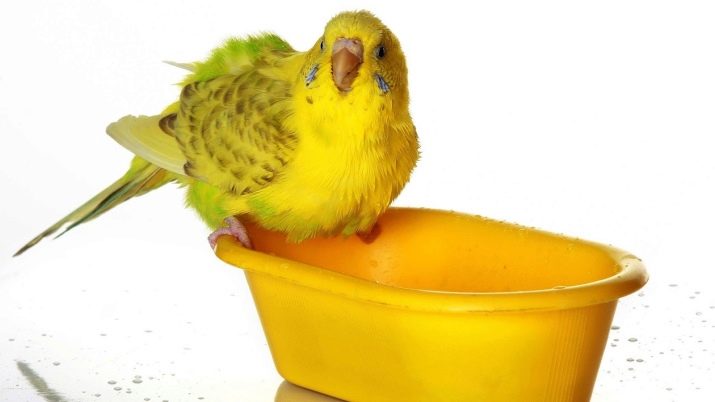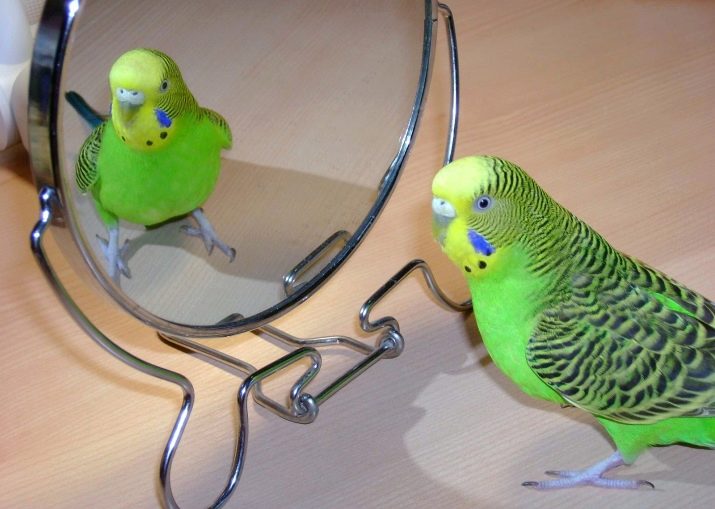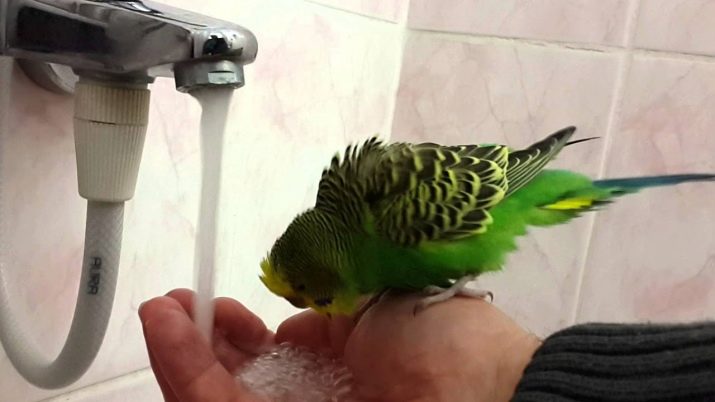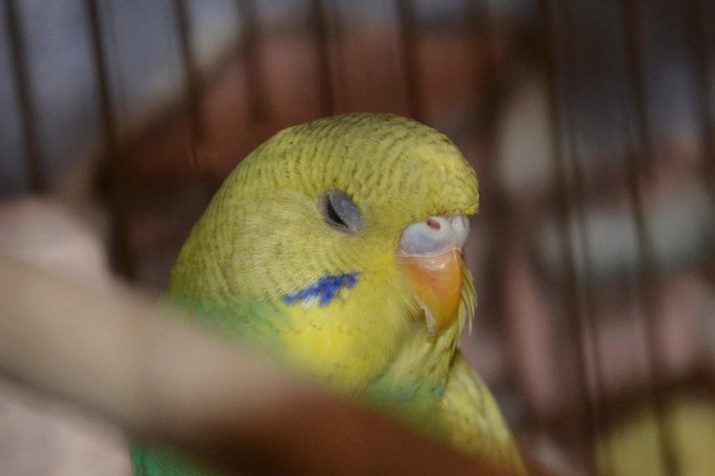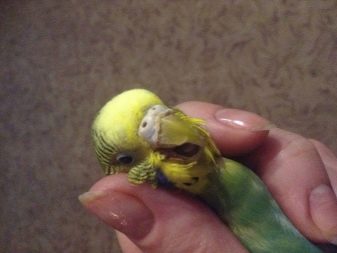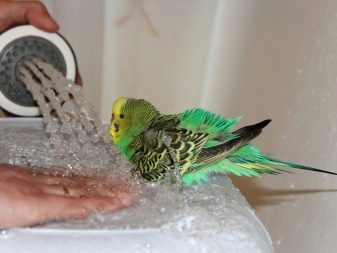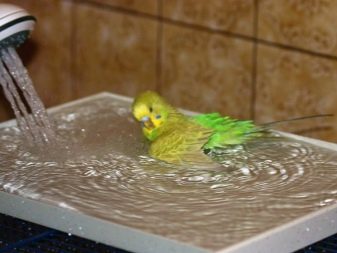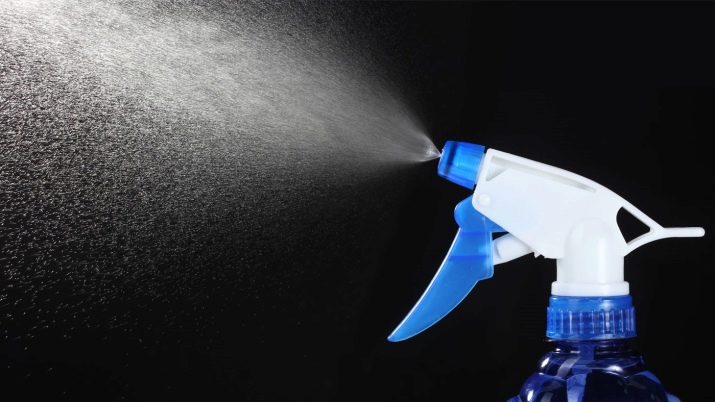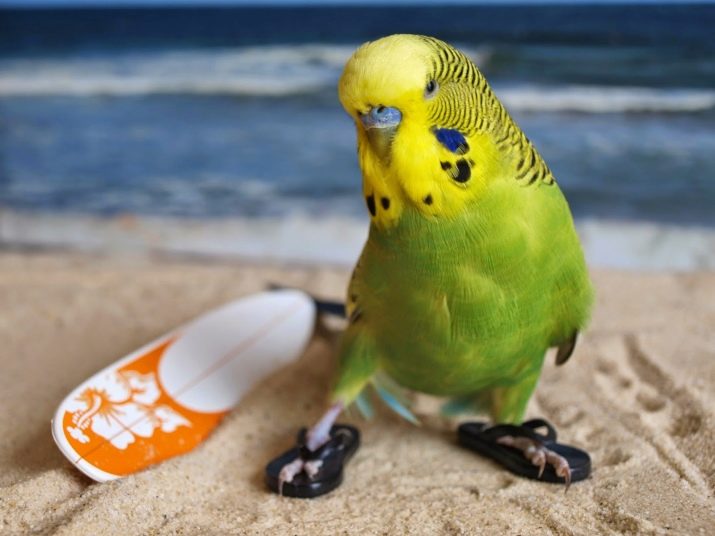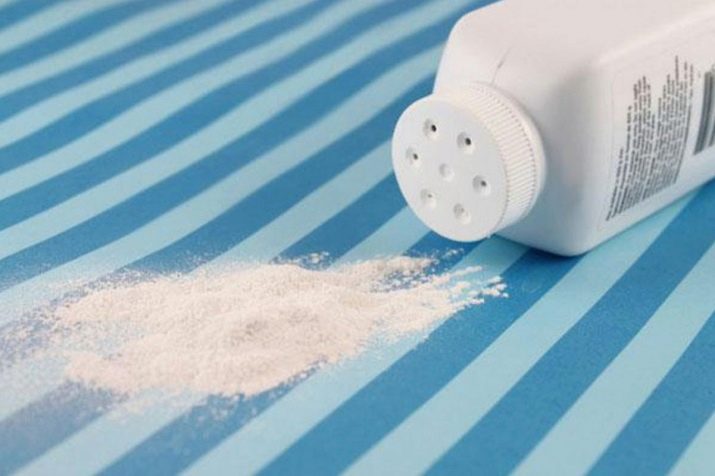The wavy parrot is a cheerful, talkative, mobile bird. For home maintenance is considered an ideal option. These slender beautiful birds with elegant plumage constantly participate in international exhibitions of decorative birds, where they are often awarded prizes. Caring for wavy is not so difficult. One of the elements of care is bathing.
Such pets live in many Russian families, successfully adapt to the microclimate of the apartments and actively reproduce in captivity.
rules
Parrots on the nature of birds cleanly, so bathing birds is not only fun exciting entertainment, but also a necessary procedure for hygiene. They can perfectly clean feathers themselves. To bathe the feathery is just to refresh it with a small amount of water. In nature, parrots bathe in drops of dew on the grass, and this is enough. In order not to harm the health of the pet, you need to follow simple rules:
- you can begin to teach the parrot to water procedures only after you have fully adapted to the new habitat (not earlier than one month after the purchase), when the pet is already well tamed;
- it is impossible to force the bird to swim forcibly, it will become the strongest stress, cause fear of water and undermine confidence;
- the light in the room should be diffused, so the parrot will be quieter (bright lighting annoys the birds);
- for bathing, take only pure warm water without chlorine (bottled or filtered, as an option - separated), a parrot can swallow water while bathing during fun games with water;
- it is allowed to add chamomile decoction into water, it improves digestion and skin condition;
- the room must be warm (not below +20 degrees), all windows are closed and the split system is turned off so that the pet does not catch a cold in the drafts;
- do not collect a lot of water in the tank, the optimum level in the bath 1.5 - 2 cm;
- Do not use a dryer for drying after bathing; this greatly dries the plumage of birds and adversely affects the skin;
- remove the water tank from the cage after bathing so that the bird cannot drink dirty water.
The term “bathing” for wavy parrots does not mean at all that detergent should be applied to their plumage, immersed in water and rubbed with a washcloth.
Training
The owner knows the nature of his pet, his favorite toys and taste preferences in the feed.
At home, it is important to properly prepare the bird and take maximum care of positive emotions when meeting with water. How the feathered will relate to water procedures in the future, to a large extent depends on how you managed to bathe him for the first time. If the parrot is interested, swimming will become a pleasant, integral part of his life.
By the beginning of bathing, the parrot should be well tamed, a special bath-bath is bought, there is a coarse spray bottle, a regular table lamp is prepared.
Be sure to take into account the mood of the bird. If the parrot is "not in the spirit", it is better to postpone the start of swimming. Accessories are important too. Often, for unknown reasons, the bird rejects the beautiful, comfortable cupboards and stubbornly prefers a plain saucer or a simple plastic lid from a glass jar. In such situations it is better to come to terms with the choice of the pet and not to insist, because it will be much more comfortable for him to use his favorite thing, rather than the brand bathing.
Waterbearing can appear from a strong fright in a bird, then water treatments will have to be abandoned for a long time, if not forever.
Training
The feathered person will observe how the host’s fingers are sprayed with sparkling droplets from the cup, and will understand that it is safe and fun. If the parrot stubbornly does not want to get acquainted with the water, you can start with an empty cupola in which to put your favorite toy, a tasty delicacy, fresh greens. In some cases, the beginning of bathing contributes to the mirror, set next to the bathing. The feathered bird will see his reflection in the mirror and decide that he is not alone here. Together it is more interesting to swim, and the parrot will decide to enter the water.
You should not hurry and push the parrot to the bathing pool, you have to be patient and wait until it voluntarily starts to drop into the bath for what lies there. When this happens, you can add a little bit of water to the bathing pool, starting with a tiny amount, gradually increasing the dose. The feathered one will not notice how he gets used and starts spraying water on himself.
Well cause interest in the water in a parrot, if you apply the elements of the game.
For each attempt to play with water, you need to encourage his favorite "snacks".
You can plant a tame parrot on your hand and bring it to a stream of water that is quietly running from an open tap. You can put a wavy on his shoulder, go with him to wash his hands and specifically hold them under the water jet, gently rubbing. Some "brave souls" jump into the sink themselves and start playing with a trickle. The owner of such a bird is very lucky - it will not be difficult to accustom him to water.
Some take pets with them to the shower room, and many parrots like to wash with the owner. But if the wavy driver is not enthusiastic about such a procedure, you should not force him to dwell in the shower for the whim of the owner, let him bathe as he chooses.
You should not substitute it under the stream, let it get used to the sounds of flowing water gradually.
Step-by-step instruction
Before swimming, you need to pay attention to the behavior of the parrot. If the pet has a not very healthy appearance, it is alarmed with something, chirps loudly and rushes uneasily around the cage, it is not necessary to offer swimming at such a moment.
There is no one way of swimming wavy parrots. The specific choice depends on the nature of the bird and the preferences of the host.
For example, consider how to bathe a bird in the bath:
- prepare a towel, hang it on a heated towel rail (it will be so warm);
- grab the wavy thumb and forefinger just above the cheeks (the other fingers hold the body of the bird) and lower it to the bottom of the empty bath without letting go of it;
- open the tap a little, the water trickle should be thin so that the parrot will not be afraid;
- adjust the temperature of the current jet;
- holding the feathery with one hand, gently rinse it with a weak stream of water;
- close the water;
- set the pet on a warm towel and slightly wet the feathers;
- put in a cage.
If he is actively interested in water in the drinker, tries to splash on himself, straightens ruffled feathers - he is ready for water procedures.
Ornithologists consider this method of bathing wavy to be the most preferable. If by neglect the parrot is very dirty, and the pollution can not be washed off with clean water, you can use a specialized bird shampoo (sold in pet shops). If part of the pollution is still on the feathers, you must carefully trim these feathers.
Possible mistakes
If you ignore the basic rules of bathing wavy parrots, problems may arise.
Here are the most common ones.
- Haste in teaching the bird to water procedures. It is impossible to allow spontaneous actions, to correct negative results is extremely difficult.
- Insufficient attention to indoor mode. As a result, the bird catches cold in the draft. At the first sign of a cold, urgent veterinary care will be required.
- Water entering the bird nasal sinuses. If such an oversight could not be avoided, it is necessary to gently hold the pet upside down for a short time, no more than 10 seconds.
Apply the product should be along the tail and carefully wash it several times so that when cleaning the feathers the bird does not poison itself with the remnants of detergent.
Alternative ways
It is possible to bathe a parrot not only with the help of a kupalka.
Spray bottle
This is an easy way to swim, but observe some rules. is necessary:
- if the pet is very shy, it is better not to use the spray gun;
- the spray gun should not spray water too fine, coarse models bring the procedure closer to natural bathing in the rain in natural conditions;
- the water in the spray should be warmer than normal bathing, it cools quickly when spraying;
- during bathing remove the trough from the cage;
- water should not be sprayed on the parrot, but above its head at a distance of about 30 cm, so that water droplets flow down on top of the bird;
- bathing time 10-15 minutes, but if the birds like, you can extend;
- After the procedure, you can turn on a regular desk lamp and put a cage under it to warm the parrot a little and dry the plumage.
Wet greens
This is the most closest to the natural conditions. The parrot rubs against the wet leaves of lettuce and grass stalks, while the feathers are moistened with drops of moisture and cleaned. This is how wild parrots bathe in dew on plants. If desired, the pet can peck delicious herbs and healthy salad.
Soft fresh grass or lettuce leaves are carefully washed and placed in a bathing room.
Fortified sand
This method is often used in winter, when there is not enough heat in the apartments, and bathing with water is impossible. Most birds with pleasure clean the feathers in sand baths, thereby ensuring the hygiene of feathers and skin. Such sand is sold in pet stores. Regular river sand is not recommended, as it may contain undesirable "neighbors" (larvae, microbes, garbage).
If a parrot is afraid of water in panic, and cannot be taught to bathe in any way, a small layer (up to 1 cm) of special fortified sand is poured into the bath and favorite toys are put.
Talc
Baby powder based on talc is gently applied to the plumage, and then removed with paper towels or a towel, together with the powder with feathers, dirt is removed. It should be noted that ornithologists prefer hygiene using water. Owners of wavy parrots need to exert maximum effort and try to ensure that the pet eventually considers the water procedures to be fun games and enthusiastically awaits them when they see the owner's preparations for bathing.
The recommended average frequency of bathing is once a month in winter and once a week in summer.
Among the wavy there are those who come from swimming in indescribable delight. They can be bathed more often, especially in hot summer, it will help to protect the birds from heat stroke as much as possible.
If you treat your pet kindly and patiently, you can quickly teach him to dabble in warm watere. The wavy fan will certainly love funny games with water and will enjoy bathing with pleasure, delivering many cheerful moments to the owner in the company of a feathered friend, because watching a splashing parrot is pure positive.
How to bathe a budgie, see below.
